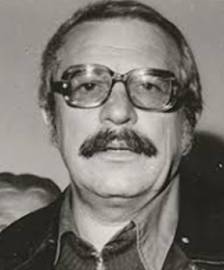Kramule Karel
1920 - 1994 Academic painter
From 1950 to 1990 he worked in the field of applied art (exhibition scenography) and at the same time devoted himself to painting, drawing and serigraphy. He was born on September 7, 1920 in Nová Paka in the Krkonoše Mountains. Before graduating from the local burgher school, he began working at Fabián's art printing house in Nová Paka, where he trained as a typesetter and typographer. From 1939 to 1944 he studied at the Zlín School of Art with professors Rudolf Wiesner and Karel Hofman. This study was decisive for its further artistic development and application in the field of architectural and artistic design of consumer goods exhibitions for the then foreign trade companies. Here he started working with the architect of the exhibition department of the Baťa company, the architect Josef Jiřičný. From 1945 to 1949 he graduated from the Academy of Arts, Architecture and Design in Prague, majoring in monumental painting with Professor Josef Kaplický, and as a student at the Academy of Arts, Architecture and Design in Prague he worked for the Satire Theater and the Young Audience Theater. He designed stage sets, costumes and posters. As part of his studies, he also visited Denmark and Sweden (1946-47), where a new field of industrial design was rapidly expanding. In 1948 Karel Kramule married Jaroslava Dontová, the couple had a daughter Dana and in 1951 a son Jan. After graduating from the Academy of Arts, Architecture and Design in Prague in 1949 until 1952, he worked in the exhibition department of PZO Centrotex. Here he became the author or co-author of exhibitions at international trade fairs in Stockholm, Izmir, Brussels and Milan. The foreign trade company Centrotex is closing its exhibition department and Karel Kramule receives an offer to stay in Iran. From 1952 to 1955 he left with his wife and both children for Tehran, where he worked as a business delegate of Centrotex to Czechoslovakia. embassy in Iran and draws and paints at the same time; captures local people, everyday life, but also tragic scenes from the period of political upheaval in Iran. After returning to Prague, he returned to free art and worked independently in the field of applied art - exhibitions. He designs trade fairs for other foreign trade companies such as Merkuria, Motokov, Kovo and Centrotex. Kramule was the author of not only the architectural design of these exhibitions, but also graphic design. Its realizations featured elements typical of the morphology of the emerging Brussels style (atomic structures, distinctive geometric shapes, triangular motifs, pastel colors), his favorite materials included light glass showcases, lightweight partitions, modern typography and work with large-format so-called solarized photos. According to the literature, he has realized more than 150 exhibitions at home and abroad: eg Leipzig (1955); Kolín n. R. (1957, 60); Sofia, Belgrade, Warsaw, Moscow (1959); Frankfurt n. M. (1960); New York (1961); Beijing (1962) ad. On the domestic stage, he designed an exhibition for the museum in Prostějov (J. Wolker's exhibition) and collaborated on the reconstruction of the Lenin Museum in Prague. He also devoted himself to industrial design. In the years 1963-65 he designed a development line of radio radios (pocket, cable, car stations, control desk, microphones and headphones) for Tesla Pardubice. As for free creation, he was very active in 1966, where two positions are clear. In one he worked with terrycloth, wax pastel covered with paint, dark shades, deep blue and free painter's handwriting predominate. Completely different are the geometric structures of strong color, in which he returned to his stay in Iran. During this period, the author seeks his artistic language and his works absorb the reverberation of everyday modernism and post-war abstraction. In March 1968, Kramule resigned from the party due to disagreement with the political direction of the Communist Party of Czechoslovakia. This decision gradually prevented him from further professional employment in the field of exhibitions, but also in freelance work (impossibility to exhibit). Over time, it became increasingly clear that Karel Kramule, a successful, independent and linguistically skilled professional with a remarkable outlook, who traveled to many countries in his field of exhibitions, became isolated both professionally and personally due to his political situation. When he was treated for an inflammatory disease of the stomach in 1970, he was helped by drinking Pilsner beer, so he began to visit pubs in Malá Strana regularly. There he met most of his neighbors in Malá Strana: Karel Pecka, Karel Kosík, Karel Kostroun, Jiří Čutka, whom he later invited to exhibitions in the garden of his studio. In the 1980s, he met the Swiss ambassador, and he and other colleagues from the diplomatic corps became regular visitors to these garden exhibitions. Karel Kramule thus gained the opportunity to exhibit and sell his work unofficially. The garden of his studio became the subject of the short story Garden party from the book Malostranské humoresky by Karel Pecka, but in a way also a certain phenomenon; a small free area of art directly below Prague Castle. Since the 1970s, the 50-year-old artist has been pursuing three art disciplines of painting, drawing and graphics (serigraphy). In painting, he progresses from figurative and geometric structures to purely abstract positions. The drawing is based on a lengthy method of fine line drawing, created
Auctions
Sale exhibitions
Contact
Copyright 2025 © Originalarte s.r.o.
